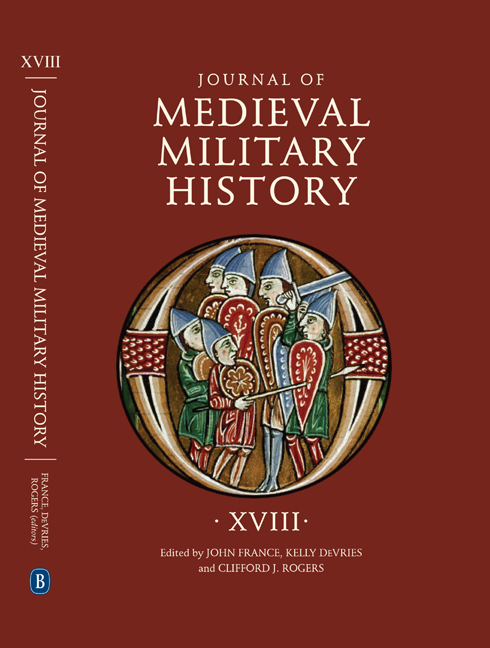Book contents
- Frontmatter
- Contents
- List of Illustrations
- 1 The Eastern Campaigns of King Henry II of Germany, 1003–17
- 2 Peace, Popular Empowerment and the First Crusade
- 3 The Transformation of Naval Warfare in Scandinavia during the Twelfth Century
- 4 Auxiliary Peoples and Military Reform on Hungary’s Western Frontier in the Thirteenth Century
- 5 What Types of Sources Did Medieval Chroniclers Use to Narrate Battles? (England and France, Twelfth to Fifteenth Centuries)
- 6 Experimental Tests of Arrows against Mail and Padding
- 7 Four Misunderstood Gunpowder Recipes of the Fourteenth Century
- 8 The Earliest Middle English Recipes for Gunpowder
- 9 Horses and Horsemen in Fifteenth-Century Siege Warfare, with Particular Reference to the Later Hundred Years War
- 10 Supplying the Army: The Siege of Pisa, 1499
- List of Contributors
- Journal of Medieval Military History 1477–545X
6 - Experimental Tests of Arrows against Mail and Padding
Published online by Cambridge University Press: 06 October 2020
- Frontmatter
- Contents
- List of Illustrations
- 1 The Eastern Campaigns of King Henry II of Germany, 1003–17
- 2 Peace, Popular Empowerment and the First Crusade
- 3 The Transformation of Naval Warfare in Scandinavia during the Twelfth Century
- 4 Auxiliary Peoples and Military Reform on Hungary’s Western Frontier in the Thirteenth Century
- 5 What Types of Sources Did Medieval Chroniclers Use to Narrate Battles? (England and France, Twelfth to Fifteenth Centuries)
- 6 Experimental Tests of Arrows against Mail and Padding
- 7 Four Misunderstood Gunpowder Recipes of the Fourteenth Century
- 8 The Earliest Middle English Recipes for Gunpowder
- 9 Horses and Horsemen in Fifteenth-Century Siege Warfare, with Particular Reference to the Later Hundred Years War
- 10 Supplying the Army: The Siege of Pisa, 1499
- List of Contributors
- Journal of Medieval Military History 1477–545X
Summary
Arrows with reproduction medieval heads were shot against multiple layers of woven linen, woven cotton, cotton wadding, woollen felt, and leather. The best protection against bodkin arrowheads was given by woven linen in combination with cotton wadding, but without mail these materials did not give significant protection against arrowheads with sharp-edged blades. Reproduction mail armor was made from mild steel, with alternating rows of solid and riveted rings. Mail alone, without a padded undergarment, did not give adequate protection against arrows shot from bows of moderate strength. Penetration to a potentially lethal depth occurred at almost every shot. The probability and depth of penetration was greatly reduced when the mail was placed over an undergarment consisting of layers of linen, or linen with cotton wadding. It was concluded that mail in combination with a garment meeting an early fourteenth-century specification for gambesons would greatly reduce, but not eliminate, the risk of fatal injury from arrows.
Mail with a padded garment (the “gambeson” or “aketon”) formed the principal armor defense for European men-at-arms until about 1325, when plate proliferated and mail was progressively relegated to protecting only those areas where flexibility was needed. Some writers regard the terms “gambeson” and “aketon” as synonymous, but Ralph Moffat argues that they were distinctly different garments. In his view the gambeson was a padded and quilted jacket that could be worn as an independent defense or over other armor, whereas the aketon, also padded and quilted, was worn under mail and was not intended as an exterior garment.
Little systematic experimental research into the effectiveness of arrows against mail has been published, and padding has often been included as an afterthought or omitted entirely. When it has been given its fair share of the researchers’ attention, it has been concluded that it is at least as important as the mail in determining protection against arrows.
The aim of the experimental work described here was to investigate the role of the gambeson or aketon in protecting against arrows, focusing on the thirteenth and early fourteenth centuries before the widespread adoption of plate armor. The principal objectives were to:
Identify which of the padding materials available in thirteenth-century Europe gave the best protection against arrows shot from a longbow;
- Type
- Chapter
- Information
- Journal of Medieval Military HistoryVolume XVIII, pp. 143 - 172Publisher: Boydell & BrewerPrint publication year: 2020

